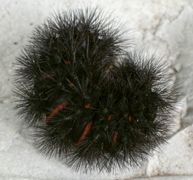 great leopard moth in a spiky ball | 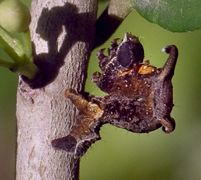 horned spanworm imitating debris | 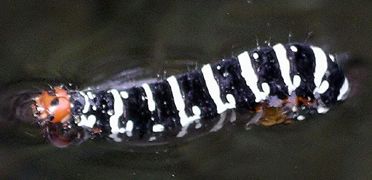 convict caterpillar swimming |
But caterpillars are not always the passive "meal on the hoof." It's true that their first line of defense is often camouflage, and many sport toxic flesh or protective spines that offer protection with no active manipulation on the part of their owner. The larvae move about to optimize feeding opportunities while minimizing exposure to danger. Some even build retreats for themselves. However, besides the inherent physical attributes or precautionary measures that keep a caterpillar safe, there is yet another aspect to their arsenal: many of these insects take on an active role when attacked.
 great leopard moth in a spiky ball |  horned spanworm imitating debris |  convict caterpillar swimming |
It is true that caterpillars are not very fast animals, so running away from danger is not a particularly great option. Many small species can rapidly scoot a short distance, either forward or back, but even the speediest of them can only do an energetic crawl. In spite of this, some of them DO flee when threatened. A common response is to simply drop off the plant to the ground. Gravity gives the larva the speed it needs. Some caterpillars use a safety line of silk (produced from glands in their mouths) much like a bungee cord, so that they don't actually hit the ground and can later crawl back up to continue grazing. Others just wait on the ground for a judicious length of time and then creep back up the stem of the plant. A few will violently fling themselves off their perches, using strong muscles to propel them a good distance. A further enhancement of this reaction is violent wiggling on the ground, which frequently results in the critter becoming hidden in leaf litter or soil. The energetic squirming has one more use: causing a caterpillar to eventually flip upside down and expose its belly. This might seem to be a pretty stupid thing to do when attacked, but some caterpillars, which are often perfectly camouflaged on top, have aposematic colors on their undersides, and flashing their warning might possibly save their lives.
All caterpillars that intentionally or accidentally fall off their host plants must somehow return to continue feeding. There is also the danger that they have fallen out of the frying pan and into the fire, as dangers lurk below as well. This is especially true for larvae that feed on plants found near water. Any fisherman knows a wiggling elongated animal is an excellent way to attract fish. Besides the threat of drowning (caterpillars breathe through holes in the sides of their bodies), falling into water is one of the surest ways to die through ingestion. As might be expected, though, caterpillars that live near water tend to be pretty good swimmers. The goal, of course, is to swim as fast as possible and get out of the water. Some caterpillars do this in snake-like fashion, writhing from side to side until they hit something solid. I've seen one species, though, with a different stroke. I was photographing Convict Caterpillars (Xanthopastis regnatrix) from my kayak as they fed on arrowroot in Florida. Due to the instability of my boat, I inadvertently knocked one of my subjects into the water. To my surprise, the insect made a beeline for the shore, moving in a perfectly straight line and at an unusually rapid and consistent pace. Intrigued by this, I put another in the water and watched closely. Instead of moving its body like a snake, the caterpillar used a motion more akin to inchworm crawling. It seemed to flatten out its normally cylindrical body, and brought its rear end up underneath and then shoved hard, like a paddle. It did this very quickly, with the result that it picked up quite a bit of speed in a short time. There was no back drift when the tail came forward, but there was obviously good thrust when it pushed back. These caterpillars had mastered the equivalent of feathering a canoe or kayak paddle so that there is less resistance on the upstroke.
Not all lepidopteran larvae are as agile as those just described. Many simply cannot run away, but a number have developed behaviors that work with their anatomical features to produce effects that may give them a second chance.
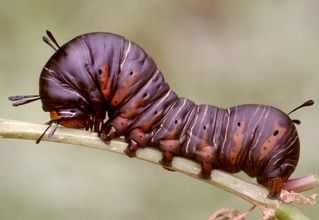 Wilson's wood-nymph swollen near head | 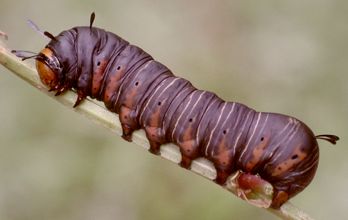 same caterpillar a few seconds later - rather deflated! |
One effective strategy for caterpillars with either chemical or spiky defenses is to remain in a group. If they have warning colors or venomous spines, the effectiveness is enhanced by the presence of a larger number. Sometimes the groups arrange themselves with their back ends together and their spine-protected heads facing outwards, reminiscent of a musk ox maneuver. Even a solitary caterpillar with plenty of bristles or spines can create its own defensive "circle" by just curling up, a tactic employed by hedgehogs and porcupines. Some prominents (moths in the family notodontidae) also rear up their heads and tails in unison, presumably creating a frightening display.
The most common defensive behavior is to freeze, thereby allowing the caterpillar's camouflage to do its job. For some species this simply means spending the daylight hours plastered flat against the matching bark of a tree and only moving to the green leaves to feed at night. Many inchworms (caterpillars in the family geometridae) when touched will straighten up while holding on with only their rear. They then resemble a twig or a bit of stem. I've seen a jumping spider actually climb right over a perfectly edible but statue-still caterpillar that it apparently did not recognize. Talk about self control!
While staying immobile, a caterpillar might change its appearance just a little bit. Since they are basically muscular tubes, there are all manner of ways that caterpillars can move bits of their skin to enhance or downplay various features. Some of the postures assumed by perturbed larvae make them almost unrecognizable, even to sharp-eyed birds, but most of these subtle (to our eyes) changes are probably aimed at smaller predators, such as spiders and wasps. Tachinid flies lay eggs on caterpillars, and the resulting maggots feed inside the hapless victims. These flies seem to prefer to lay their eggs near the head, probably so the caterpillar cannot reach around and bite them off. From some other observations I've made, it appears that some ichneumon wasps prefer to insert their eggs into the rear end of the larva. There are other wasps that lay their eggs about 1/3 of the way back from the head of the caterpillar. So, to lots of parasitoids, telling head from tail on caterpillars is important. As might be expected, many of the targets have physical attributes that make this difficult. Head and tail might have similar colors or patterns or even shapes. On top of that, some caterpillars "adjust" their bodies when they feel threatened. Hornworms, which are the larvae of sphinx moths, sometimes inflate or deflate their front ends. In fact, the common name "sphinx" comes from the characteristic position many of the caterpillars assume when disturbed. One curious display occurred with a Wilson's Wood-nymph (Xerociris wilsonii) larva that I was photographing. First the caterpillar curled its head up and made its front end very swollen. Then suddenly, obviously due to how I happened to touch it, the front end shrank and the butt was suddenly much more prominent! The caterpillar had deceptively reversed its apparent orientation.
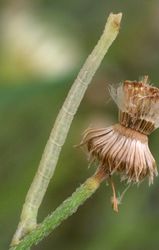 blackberry looper imitating a stick | 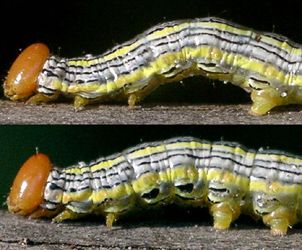 white-headed prominent opening side "eyes" | 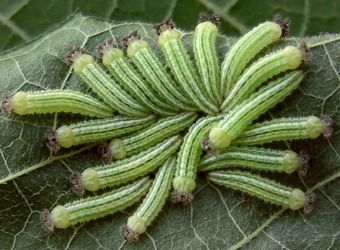 tawny emperors in a tight protective cluster |
Many tiny wasps oviposit in the center area of a larva. Spiders also tend to bite them in the middle. It is therefore no surprise that caterpillars need to have defenses against side attacks as well as those occurring at both ends. Because we rarely get down on the micro level with insects, many of these small but significant interactions have not been well documented. I was recently photographing an attractive White-headed Prominent (Symmerista albifrons) caterpillar and spent some time getting a good side view shot. I took about a dozen photographs as I tried for good focus. When I later looked at the images, the last two showed a change in the markings that can only be described as resembling the sudden appearance of a pair of eyes! My scary looking camera lens prompted the caterpillar to adjust muscles around its side markings, punctuating a series of thin black lines with two very conspicuous black blotches. These appeared right at the gap between the thoracic legs and the abdominal prolegs, so that they were framed by legs on both sides. The similarity to a frontal view of a jumping spider cannot be coincidental.
Touching a caterpillar in the middle will sometimes cause it to thrash about, which is probably effective against small wasps trying to lay their eggs. One other way that caterpillars can ward off midriff attacks is by using a startle effect of color. From a simple slit that shows black or red to the opening of false eye spots, these visual tricks can be aimed at everything from miniscule wasps to birds.
One of the most remarkable reactions to being touched occurs with swallowtail butterfly caterpillars (family papilionidae). These insects have the usual camouflage, and many sport frightening false eye spots too. Some also inflate their thorax and display a vivid black line. But the most intriguing character they possess is the osmeterium. This is an organ that is normally hidden but can be everted from just behind the head when they are bothered. The ones I've seen are orange and have a pungent smell. When a wasp encounters this, it usually leaves immediately and sometimes even acts as if it has been poisoned.
Another kind of caterpillar also uses evertible projections. The Black-etched Prominent (Cerura scitiscripta) has extraordinarily altered anal prolegs (the back pair of false legs usually used to hold the caterpillar in place). When this species is harassed it extends those rear prolegs to an incredible degree. The normally green protrusions spew out thin red and yellow filaments which the insect flails around as if trying to whip an attacker.
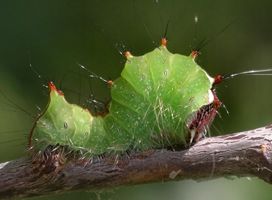 clear dagger resembling a green blob | 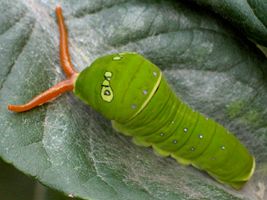 two-tailed swallowtail showing off osmeterium | 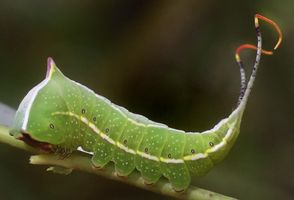 black-etched prominent whipping its anal prolegs |
When things get desperate, such as when a caterpillar is actually grabbed, presumably to be eaten, a very common reaction is to puke. Disgorging stomach contents works for other animals too, including snakes, birds and grasshoppers. Anyone who has disturbed a vulture nestling knows the effectiveness of projectile vomiting! Besides just being disgusting, the chemicals in the upchucked fluid probably at least taste bad and might be an irritant as well.
A final action that some caterpillars take is to bite. At least they act like they are doing that, but it doesn't really have much effect against humans. The vehemence with which they lash out, though, might surprise you into dropping them.
For slow-moving immature insects with lousy eyesight and soft bodies, basically just eating machines, caterpillars have quite a remarkable array of tricks up their proverbial sleeves.